
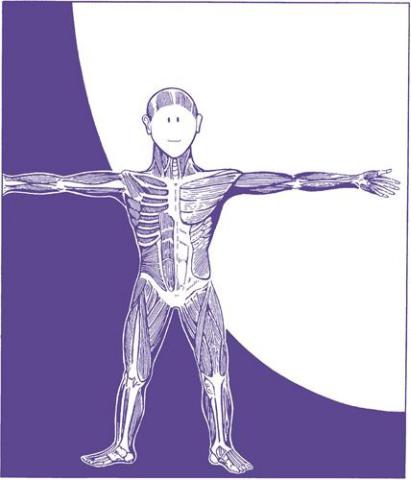
THE HUMAN BODY
THE FIVE SENSES
Our body is an amazing creation. In this chapter, you’ll discover some of its many abilities that qualify it as a machine you won’t find anywhere else in the universe. For now, though, let’s focus on the ways we interact with the world around us. We have five senses: touch, taste, hearing, sight, and smell. Each of these senses allows us to understand the world in a different way and gives us a unique perspective on what we encounter each day.
Facts Fun
Braille is a system of writing using raised bumps on a page that allows blind people to read. It was developed in 1829 by twenty-year-old Louis Braille, a Frenchman who lost his sight at the age of three.
TRY THIS HOT AND COLD
QUESTION
What makes us feel hot and cold?
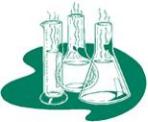
Science Online
For more fun activities involving your five senses, check out Neuroscience for Kids. Visit http://faculty.washington.edu/chudler/chsense.html
MATERIALS
3 bowls of water: 1 warm, 1 cold, and 1 at room temperature.
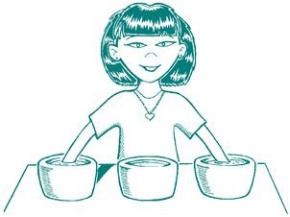
What did the clever scientist invent that was full of holes but could still hold
water?
A sponge!
PROCEDURE
1.Arrange the bowls of water in front of you from left to right as follows: warm, room temperature, cold.
2.Place your left hand in the bowl of warm water and your right hand in the bowl of cold water for 30 seconds.
3.Remove your hands from the water and place both into the middle bowl (room temperature).
WHAT’S HAPPENING
Hot and cold are just a way of comparing what we are used to with what we are feeling. Your left hand was used to warm water, so when you placed it into the bowl with water at room temperature, it felt quite cold. On the other side, your right hand was used to cold water, so when you placed it into roomtemperature water, it felt warm. Both hands were in the same water, but since they were used to different temperatures, one felt cold and the other felt warm.
Fun Facts
Insects use their antennae for up to four of their senses: touch, smell, taste, and hearing.
FOLLOW-UP
Next time you take a bath or a shower, think about how the bathroom air feels when you get out. Ask someone who is dry to tell you how the air feels and see if you can explain why you perceive the air differently. Another place to try this is at a swimming pool. Try to explain how warm or cold the air and water feel when you are dry and when you are wet. Heat flows naturally from warm objects to cool objects and makes us feel warm or cold as a result.
Did you hear about the scientist who invented a gas that could burn through
anything ?
Wow, that’s terrific!
No, it’s terrible — now he’s trying to invent something to keep it in!
TRY THIS TASTELESS MEDICINE
QUESTION
Why can’t I taste medicine when I plug my nose?
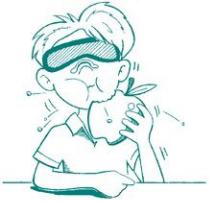
How many scientists does it take to make a stink bomb?
A phew!
MATERIALS
Blindfold Nose plug or your hand Equal-sized pieces of apple, potato, onion,
and jicama Assistant
PROCEDURE
1.Place the blindfold over your eyes and plug your nose.
2.Have your assistant place one item into your mouth at a time, and try to guess what it is based only on how it tastes.
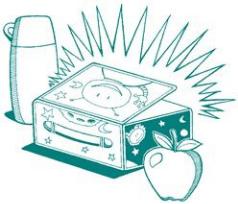
Cool Quotes
Smell is a potent wizard that transports us across thousands of miles and all the years we have lived.
— Helen Keller 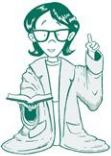
WHAT’S HAPPENING
Your sense of smell is a major factor in how food items taste. When your nose is plugged, you lose your normal ability to taste. Aside from their textures, you probably couldn’t detect the difference between the items you tasted. When you unplug your nose, all the flavors should come back, although the strongest ones might overwhelm the others.
FOLLOW-UP
Have you ever had a really bad cold? If so, you might remember that your
food tasted pretty bland. When your nose is stuffed up, you again lose the sense of taste that you are accustomed to. As soon as your cold cleared up, you were able to taste things again!
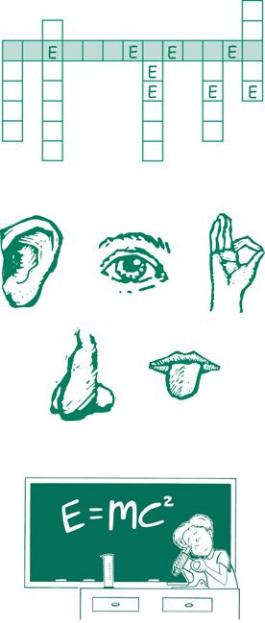
What’s Going On?
Can you figure out these small picture clues? When you think of a word to go with each picture, fit it in the grid going up and down. Then you will need to add some extra letters to the shaded row. When you’re finished, you will have the name of a group of important body functions. We gave you the Es to help you complete this experiment!
KIDS’ LAB LESSONS
QUESTION How can I taste different flavors?
EXPERIMENT OVERVIEW In this experiment you will place different food items on different locations of your tongue to determine which taste buds can sense which flavors. You’ll test sweet, sour, bitter, and salty.

taste buds: little organs all over our tongues that interpret or pick up the sense of what flavors are in our food and liquids.
SCIENCE CONCEPT Our tongue has thousands of tiny taste buds on it. Each one reacts to a certain kind of taste. Taste buds that respond to the same taste are grouped together in certain locations on your tongue. Therefore, you will always taste salty foods in certain places, sweet foods in other places, and sour and bitter foods in still other places, no matter what food you are eating.
MATERIALS
Cotton swabs Small bowls containing the following: Lemon juice Water
Sugar
Table salt Instant coffee A diagram of the tongue Marking pen
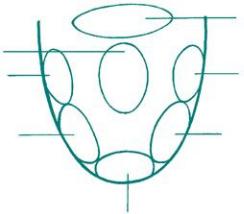
Fun Facts
Atypical human has around 116 taste buds per square centimeter at the tip of the tongue, compared to an average of 25 taste buds per square centimeter near the back of the tongue.
PROCEDURE
1.Dip a cotton swab in the lemon juice and spread it around your mouth.
2.Mark on the diagram where on your tongue you sensed this sour taste.
3.Dip a second cotton swab in water and then into the sugar. Spread enough around in your mouth so that you can tell where your tongue senses this sweet taste.
4.Repeat this same procedure with the salt and the instant coffee (a bitter taste).
5.Record on the picture the locations where you sensed each taste.
6.Check your picture to make sure that you have covered each part of the tongue. If you missed one, repeat the experiment to find the taste sensed by that part of the tongue.
QUESTIONS FOR THE SCIENTIST
 Which parts of the tongue responded to sour?
Which parts of the tongue responded to sour?
 Which parts of the tongue responded to sweet?
Which parts of the tongue responded to sweet?
 Which parts of the tongue responded to salty?
Which parts of the tongue responded to salty?
 Which parts of the tongue responded to bitter?
Which parts of the tongue responded to bitter?
 Does your diagram of the tongue explain the location of sores after eating too much sugar?
Does your diagram of the tongue explain the location of sores after eating too much sugar?
FOLLOW-UP
Try other foods that you know to be in one of these four categories. When you eat them, try to see if you can taste them on the part of your tongue that you marked in this experiment. Try plugging your nose and testing for these four tastes. Does your nose affect your ability to recognize tastes?1
TRY THIS CYAN, BLACK, AND YELLOW
Have you ever looked at a picture that had really bright colors only to find that when you looked away, you saw even more colors, though different from the ones in the picture? If so, you’ve experienced another side of afterimages. You learned a little about these earlier in the book, but there’s more to the story. Your eyes have the ability not only to “see” two images at a time, as you discovered in the “Bird Cage” experiment, but they can also block certain colors and keep them from being seen.

complementary color: a color that is the opposite of another color.
QUESTION
What colors can you see in an afterimage?
MATERIALS
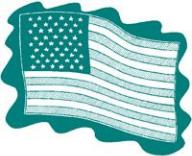
Several sheets of paper
Marking pens, including blue, red, green, black, yellow, and cyan (like
turquoise or teal) Color picture of the American flag
PROCEDURE
1.On your first three sheets of paper, draw large circles. On sheet one filling the circle in red. On sheet two make it blue, and on sheet three make it green.
2.In order, focus your eyes on each of the circles (one at a time) for about 30 seconds.
3.After focusing on each of the circles, either look at a blank sheet of white paper or simply close your eyes. Describe the colors you see.
4.Next, focus your eyes on the picture of the American flag, again for about 30 seconds.
5.Look away and describe the new colors of the flag you see as an afterimage.
6.Try to draw an afterimage American flag. Make the stripes black and cyan, while the stars should also be black, but set on a yellow background. Use the picture of the actual flag as a guide.
7.When you are done, focus intently on your flag, then look away. Do you see the true colors of the flag?
WHAT’S HAPPENING
Your eyes use cones to detect colors. When you focus your eyes on a certain color, like green, your cones work extra hard to help you see that color. Then, when you look away, the cones for that color relax and temporarily don’t work as well. Therefore you see everything but the original color. The term for what you see is complementary color. Can you tell which colors you see as afterimages of red, green, and blue?2
When you viewed the American flag, your cones focused on red, white, and blue. When you relaxed your eyes by looking away, the afterimage you saw was of the complementary colors of red, white, and blue. Those colors are cyan, black, and yellow.
FOLLOW-UP
Figure out which eye is your dominant one. Try the following test:
 Hold up a tube to your eye — which eye do you close and which do you use to sight through the tube?
Hold up a tube to your eye — which eye do you close and which do you use to sight through the tube?

I Can’t Believe My Eyes!
Do your eyes always see things in just one way? No! Optical illusions are a kind of puzzle designed to fool your eyes (and your brain). See if you can tell the difference between illusion and reality in the following puzzles.
Do you see a 13 or a B in the center of the figures above?
What do you see where the white lines cross?
Are the long black lines parallel (even) with each other, or are they crooked?

Which line is longer?
KIDS’ LAB LESSONS
QUESTION How does my eye work?
EXPERIMENT OVERVIEW In this experiment you’ll build a model that shows you what kinds of images your eyes form. You can determine the size of the image and will see how to extend this concept to building a pinhole camera.

image: what we see when we look at something. The image is formed in our head and transferred to our brain.
pinhole camera: a device which allows you to look at an object indirectly. lens: an optical device that bends light rays and makes it possible for us to
see.
SCIENCE CONCEPT Your eye is a complex device designed to gather light, focus it onto your retina, and send signals to your brain about what you are seeing. The lens of your eye takes light rays from all around you and focuses them to a single spot on the back of your eye. There, the rods and cones turn that image into something your brain can understand. As complex as your eye is, you can build a model of your eye that produces an image that is quite similar to what your eye produces.
MATERIALS
Safety pin Paper cup
Rubber band Wax paper
Bare light bulb, turned on 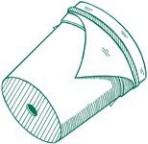
PROCEDURE
1.Poke a small hole with the pin in the bottom of the cup.If you want to make it bigger later on, you can. For now, keep it pretty small.
2.Use the rubber band to secure a square of wax paper across the top of the cup. This will be your screen.
3.Point the bottom of the cup at the light bulb from a distance of 2 to 3 feet.
4.Slowly move toward the light while keeping a close eye on the wax paper.
5.When you get close enough, you will see an image of the light bulb on the wax paper, but it will be upside down.
Fun Facts
Worker bees have 5,500 lenses in each eye.
The first pinhole cameras were actually rooms that were very dark except for a small hole in one wall that let light in. In fact, the Italian word for room is “camera”!
QUESTIONS FOR THE SCIENTIST
 How close did you get to the light before you could see the light bulb’s image on the wax paper?
How close did you get to the light before you could see the light bulb’s image on the wax paper?
 How does this distance change if you make the hole in the bottom of the cup slightly bigger?
How does this distance change if you make the hole in the bottom of the cup slightly bigger?
 Why is the image upside down?
Why is the image upside down?
 How is this similar to the way a camera works?
How is this similar to the way a camera works?
FOLLOW-UP
Now that you have built this model of your eye, you are ready to build a pinhole camera, which operates on many of the same principles.
You will need a ruler, an empty can of Pringles potato chips, a knife (with help from an adult), a thumbtack, tape, and aluminum foil.
1.Measure 2 to 3 inches from the bottom of the can and have an adult cut the tube into two smaller tubes.
2.Use the thumbtack to poke a small hole in the bottom of the smaller tube and place the plastic lid of the original can on top.
3.Place the larger tube on top of the smaller tube so that the lid lies between them. Tape these together to re-form the original tube.
4.Wrap aluminum foil around the whole tube. This needs to keep as much light out as possible so make sure you cover the entire can.
5.Hold the open end close to your eye and look into the tube. You should see inverted images projected on the screen (the plastic lid).
HUMAN MACHINE
Human beings have produced some remarkable machines in the past hundred years or so. The airplane, the automobile, and the computer are just a few examples of machines invented by ordinary people that have forever changed our lives. But if you want to see a machine that is more complex, more beautiful, and more unique than any of these, look in the mirror. Our bodies are capable of things that no machine will ever be able to accomplish, no matter how powerful computers get. As we wrap this book up, let’s take a look at some of the wonderful things human bodies can do.

machine: a device that performs a specific task.
lungs: the sacks in our chest that fill up with air when we breathe.
TRY THIS DEEP BREATH
QUESTION
How much air can my lungs hold?
Facts Fun
Swimmer Amy van Dyken won four gold medals at the 1996 Olympic Games in Atlanta despite having only 65 percent of the lung capacity of an average person due to asthma.
MATERIALS
Large, empty 1-gallon glass jar 32-ounce (quart) glass jar Water
Large flat container, for example, an aquarium Permanent marker 3 flat stones or other flat items Sink or location that can get wet 18 to 24 inches of rubber tubing 1 sheet of paper
1 writing utensil
Why did the scientist take his nose apart?
He wanted to see what made it run!
PROCEDURE
1.Fill the large jar by repeatedly filling the 32-ounce jar with water and emptying it into the large jar.
2.After each quart of water is added, make a mark on the jar indicating the height of one quart.
3.Fill the aquarium about three-quarters full of water and place the stones in a circle on the bottom.
4.Place the aquarium in the sink. Carefully turn the large jar over and place it on the stones on the bottom of the aquarium. Don’t worry if some water spills out.
5.Make a note of the initial water level in the jar. This will be your starting point.
6.Place one end of the rubber tubing into the aquarium and under the mouth of the jar. Let the other end hang over the side of the aquarium.
7.Take a deep breath and blow into the free end of the rubber tubing.
8.Measure the resulting mark of the water in the jar.
9.Subtract the original mark to find your lung capacity in quarts.
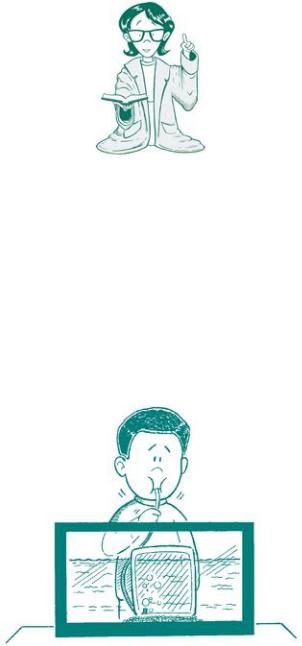
Cool Quotes
The simplest schoolboy is now familiar with truths for which Archimedes would have sacrificed his life.
— Ernest Renan, French philosopher and theologian
WHAT’S HAPPENING
When you blow air out of your lungs and into the jar, it replaces some of the water. The water level will rise in the aquarium. You can measure how much air was added to the jar to see how much air your lungs held. Try this experiment again and see if you can improve your results.
TRY THIS ACTION-REACTION
Every time someone gets into a car to drive, they must make decisions that will keep them safe. Some of them can be made slowly, for example, whether or not to roll the window down, while others must be made very quickly, such as swerving to avoid a collision with another car.
The silly scientist discovered something that has a bottom at the top — what is
it?
Your legs!
QUESTION
What is my reaction time?
MATERIALS
Dollar bill or note card
Friend
Ruler

Fun Facts
The typical human reaction time in an experiment like the one you performed is around 0.20 seconds.
PROCEDURE
1.Hold the dollar bill vertically lengthwise with one hand while placing your other hand’s thumb and forefinger near the bottom of it.
2.Drop the bill and catch it with your other hand. You should be able to do this easily.
3.Now have your friend do the dropping. You should not know when the bill is to be dropped.
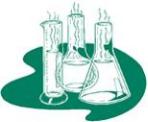
Science Online
Visit a human body online at www.pa.k12.ri.us/Curric/Science/Human1.htm
Cool Quotes
Every science begins as philosophy and ends as art.
— Will Durant 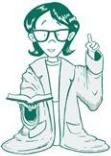
WHAT’S HAPPENING
When you dropped the bill, your brain was able to send a signal to your other hand telling it to start catching it. When your friend dropped the bill, you didn’t have that head start, so you got a more accurate reading for your reaction time. The lower on the bill you were able to catch it, the faster your reaction time. If you weren’t able to catch it at all, you aren’t alone. Try dropping a ruler instead.3
FOLLOW-UP
This reaction time test is one of many you could do. See if you can come up with your own test.
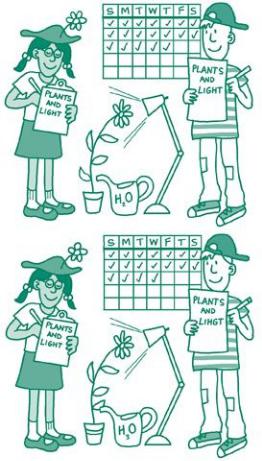
I See!
If you are conducting experiments you must use your powers of observation
— that means you must look very carefully at your information so as not to miss an important detail! Practice your powers by finding the 10 differences between these two pictures.

KIDS’ LAB LESSONS
QUESTION What is my pulse?
EXPERIMENT OVERVIEW In this experiment you’ll be measuring your pulse (heart rate) after several different activities. You’ll also learn how to use different time intervals to measure your heart rate and where the best places are to find your heartbeat.
SCIENCE CONCEPT Each time your heart beats it delivers oxygen-rich blood to your body, which allows it to function properly. When you are resting, your heart rate slows down, as your body doesn’t need as much blood as it does when you exercise. People who are in good physical condition are able to engage in strenuous activities while keeping their heart rate low. On your body, the strongest beats can usually be felt over your heart, in your neck just below your jaw, on the inside of your wrists, and on your thumbs.

pulse/heart rate: how many times per minute your heart beats.
MATERIALS Stopwatch PROCEDURE
1.Sit quietly for a few minutes before beginning this test.
2.When you are ready, place your first two fingers either on your neck or on the inside of your wrist and locate your pulse.
3.Once you find your pulse, start the watch and for 60 seconds, count the number of beats you feel. That is your pulse.
4.Try the experiment again, but this time count for only 30 seconds. When you are done, multiply your count by two. Compare your pulses.
5.Repeat by counting for 15 seconds and multiplying your count by four, then counting for 10 seconds and multiplying by six.
6.Once you have determined your resting pulse, go somewhere that you can exercise vigorously for at least one minute. Exercise of this sort might include a fast jog, running stairs, skipping rope, or doing pushups. When you are done, you should be breathing hard. CAUTION: Do not exert yourself beyond what you are comfortable with. Pick an activity you can do safely.
7.Choose the length of the test you wish to perform and find your pulse again.
8.Compare your resting pulse with your pulse after exercise.
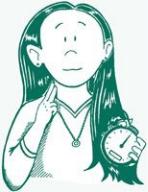
Fun Facts
People should exercise so that their heart rate is between 60 percent and 90 percent of their maximum rate.
QUESTIONS FOR THE SCIENTIST
 What was your resting pulse?
What was your resting pulse?
 Which result(s) did you use to come up with this number?
Which result(s) did you use to come up with this number?
 What was your pulse after exercise?
What was your pulse after exercise?
 What are the advantages to timing for a full minute to find your pulse?
What are the advantages to timing for a full minute to find your pulse?
 What are the advantages to timing over a shorter period of time (like 10 seconds), especially when you have just finished exercising?
What are the advantages to timing over a shorter period of time (like 10 seconds), especially when you have just finished exercising?
 The American Heart Association has determined that the maximum heart rate should be 220 minus a person’s age. Was your highest rate below that number?
The American Heart Association has determined that the maximum heart rate should be 220 minus a person’s age. Was your highest rate below that number?
FOLLOW-UP
Regular exercise can reduce both your resting heart rate and your heart rate after exercise. For a long-term study of your own heart rate, try exercising for 15 to 20 minutes daily for one month. Once a week, recheck your heart rates before and after exercise to see if they go down. If you plan on drastically changing your exercise patterns, check with your parents or your doctor to make sure the change is appropriate for you.
TRY THIS BLIND BALANCE
One of the most fun things to do as a kid is to spin around really fast and get dizzy. Our sense of balance comes from our ears and the liquid inside them that sometimes gets sloshed around. When it calms down, the dizziness generally goes away. Balance is a difficult condition to understand. So is the question of why some people get dizzy riding in the back seat of a car or on a boat while others can ride the wildest roller coasters or perform as gymnasts or figure skaters and never get the slightest bit dizzy.

balance: your ability to stay standing without falling over.
QUESTION
Is it harder to balance with your eyes closed?
MATERIALS
None
Fun Facts
One of the most natural and effective cures for motion sickness is ginger. Some people eat gingersnap cookies, while others drink ginger ale.
PROCEDURE
1.Stand on both feet in the middle of the room.
2.Try to balance for 30 seconds.
3.Close both eyes and try to balance for 30 seconds. Compare the difficulty of the two tasks.
4.Stand on one leg and balance for 15 seconds. Do not touch anything for support.
5.Close your eyes, stand on one leg, and try to balance for 15 seconds.
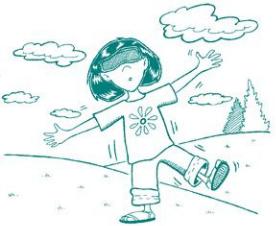
What kind of scientist studies shopping?
A buy-ologist!
WHAT’S HAPPENING
Much of your sense of balance comes from your ability to see your surroundings. When you lose the ability to measure your balance with respect to the room (by closing your eyes) you have a harder time keeping your balance. People who get seasick on a boat have a similar problem. They look out at the land and water and it’s all moving. Since there is no fixed point that they can look at, they lose their balance (and sometimes much more).
FOLLOW-UP
Try standing very close to a wall and repeating the experiment with one leg and both legs. This time, lightly touch the wall. Try not to use it for balance, just to remind you that it’s there. Does it help you stay balanced?4
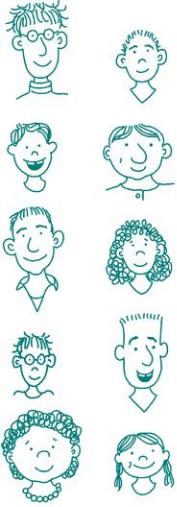
Boy, Do You Look Familiar!
Do parents and their children look exactly alike? No, but often people can pick family members out of a group. Study the following faces and see if you can do it, too. Draw a line matching each pair of relatives.

KIDS’ LAB LESSONS
QUESTION Where is my center of gravity?
EXPERIMENT OVERVIEW In this experiment you’ll perform several physical tasks along with other people to determine the differences between the center of gravity of a man and a woman, as well as the differences between kids and adults.

center of gravity: your body’s balance point.
SCIENCE CONCEPT Every object has a center of gravity. It is the part of the object that must be supported to keep from falling over. Adult men and women have different centers of gravity, as you will see. Kids, due to the fact that they have not yet physically developed like adults have, don’t always show those same differences.
MATERIALS
Adults and kids of both sexes Wall
Coffee cup
Stool
PROCEDURE Have each participant try these tasks. See who can complete
them.
Test 1
1.Stand next to a wall so that one side of your body, including your foot, is touching the wall.
2.Try to lift your other foot off the ground and stay standing.
Test 2
1.Place the coffee cup 8 to 10 inches in front of your feet while standing in the middle of a room.
2.Bend over and pick up the cup.
3.Now move so that you are standing with your back and feet to a wall.
4.Place the cup 8 to 10 inches in front of you and try to bend over and pick it up.
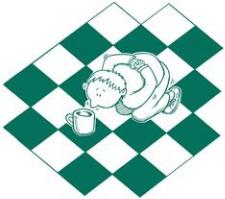
5.Try to describe why this second task is so difficult. Repeat the original test in the middle of the room if you wish.
Test 3
1.Kneel on the floor and place the coffee cup the length of your forearm in front of your knees.
2.Place your hands behind your back and try to knock the cup over with your nose.
Test 4
1.Stand with your feet together, about 2 feet in front of a wall.
2.Have someone place a stool between your feet and the wall.
3.Lean toward the wall until your forehead is touching it. Keep your back straight while you do this.
4.Pick up the stool and hold it to your chest.
5.From this position, try to straighten your back and stand up.
QUESTIONS FOR THE SCIENTIST
 In Test 1, why do you fall immediately when you lift your outside leg?
In Test 1, why do you fall immediately when you lift your outside leg?
 Try this same test in the middle of the room. Why don’t you fall?
Try this same test in the middle of the room. Why don’t you fall?
 Why are you able to pick up the cup while standing in the middle of the room, but you can’t reach it with your back against the wall?
Why are you able to pick up the cup while standing in the middle of the room, but you can’t reach it with your back against the wall?
 Is there a difference in performance between men and women, or between adults and kids, for the first two tests?
Is there a difference in performance between men and women, or between adults and kids, for the first two tests?
 Is there a difference in performance between men and women, or between adults and kids, for the last two tests?
Is there a difference in performance between men and women, or between adults and kids, for the last two tests?
 Thinking about the idea of center of gravity, why do you suppose women have an easier time with the last two tests than men do?
Thinking about the idea of center of gravity, why do you suppose women have an easier time with the last two tests than men do?
 Kids tend to do better on these final tasks than adult men do. Can you think of a reason why this might be?
Kids tend to do better on these final tasks than adult men do. Can you think of a reason why this might be?
FOLLOW-UP
Think up other interesting tests you can perform to test for center of gravity.5
Also, think of jobs or sports that require good balance and a knowledge of center of gravity. Do you engage in an activity that requires you to keep your balance? If so, think about where your center of gravity is during that activity.
SCIENCE FAIR PROJECT: HUMAN BODY
GENETICS
Perhaps people have told you that you “look just like your mother” or that you “have your father’s eyes.” If you have siblings, you may see no resemblance, while others say, “I can tell you are related.” What is it about our looks that says so much about who we are and where we came from? The answer lies in our genes — the blueprint for how we are made. Each of us inherits our genes from our biological parents. But some traits or characteristics are more common, or dominant, in our families, while others are recessive, or less likely to occur. We can’t easily look inside our genetic code to see what traits we inherited from which parent, but we can use a survey and probability to predict the patterns.
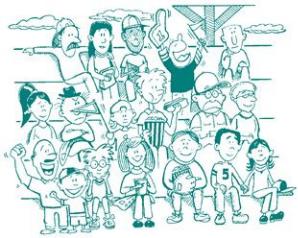
QUESTION
Why are my eyes green?
EXPERIMENT OVERVIEW
In this experiment you and your parents will complete a survey that asks about certain inherited traits, or traits that you have no control over. Then you’ll pick two of them to complete a probability study using a tool called a Punnett square.
SCIENCE CONCEPT
Traits like hair or eye color, attached ear lobes, hitchhiker’s thumb, and the ability to roll your tongue are called dominant or recessive. Each of us has two genes for each trait in us — one we inherited from our mother and one from our father. As you might expect, a person who has two dominant genes or two recessive genes will have that trait. However, a person with one of each will display the trait of the dominant gene even though they possess the recessive gene as well. Here’s an example.
Suppose you own two black rabbits and they produce a baby rabbit. In rabbits, black fur is a dominant gene (shown as a capital letter) and brown is a recessive
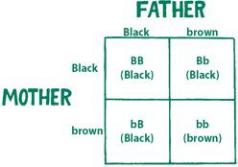
gene (shown as a lowercase letter). Let’s suppose in this case that your two rabbits each have a black and a brown fur gene. Can you explain why they both have black fur? When they have a baby, the baby will inherit one of the many combinations of fur genes from its parents — either two blacks, a brown and a black, or two browns. In the first two cases, the baby will also have black fur. There is actually a 75 percent chance that this will happen. But there is a 25 percent chance that the baby will inherit both parents’ brown fur genes and will be born with brown fur. That is, two black rabbits can produce a brown rabbit.
The Punnett square below shows how this could happen.
So if both of your parents have brown eyes but yours are green, that is a perfectly reasonable possibility.
MATERIALS
Survey (at the end of the chapter) You and your biological parents. If this isn’t possible, find someone who has access to his or her biological parents and ask him to help you.
Punnett square 2 coins
PROCEDURE
1.Complete the survey; then ask each of your parents to complete it as well. If you can think of other traits to include, add them.
2.Talk with your parents about the results. Discuss how many of the traits of each parent you have.
3.Pick two of the traits for the second part of the experiment. One should be a trait that both parents have in common but you do not have, if possible. Otherwise, just pick a trait that you all have in common. The second should be a trait that your parents differ on.
4.For each trait you select, build a Punnett square that could produce your family’s results. A sample is shown below. Mother has green eyes, father has brown eyes, child has green eyes. In this case, the brown gene is dominant over the green gene. This could occur in either of the combinations on the right.
5.Count the number of smaller squares that could produce your results. For the example above, there are two.
6.Divide this number by four, the total number of squares, to determine the probability, or chance, of this result occurring. For this example, the probability is 50 percent.
7.On a piece of paper, decide which gene will be represented by heads and which will be tails for each coin you will be flipping. It might be easier to use different coins to represent each parent.
8.Toss both coins 20 times for each trait. Count the number of times you get a result that matches your own results (in our example, the result we’re looking for is that the child has green eyes) and divide that number by 20. This is your experimental probability.
9.Compare your experimental probability with your theoretical probability and present your findings.
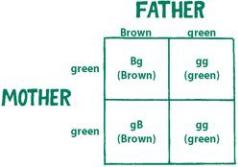
QUESTIONS FOR THE SCIENTIST
 Are there any traits that your parents share but that you do not possess? What are they?
Are there any traits that your parents share but that you do not possess? What are they?
 Are there traits that all three of you share?
Are there traits that all three of you share?
 Do you think these traits are carried by dominant or recessive genes?
Do you think these traits are carried by dominant or recessive genes?
 How close were your experimental results to the values you calculated from the Punnett square?
How close were your experimental results to the values you calculated from the Punnett square?
 What does it mean if your results don’t match your predictions?
What does it mean if your results don’t match your predictions?
 Does the Punnett square mean that if a mother and father have four children each child will fit into one of the squares? Why or why not?
Does the Punnett square mean that if a mother and father have four children each child will fit into one of the squares? Why or why not?
CONCLUSION
Genetics is one of the most fascinating and scary topics in biological research today. From cloning to disease prevention, doctors are searching for ways to improve our lives by understanding what it is we are made of. So far, there is no guaranteed way to predict the traits of one’s children, and that’s probably a good thing. However, an understanding of your past helps you prepare for your future and that’s one of the many reasons why children who are adopted try to find their birth parents. No matter who we are, it’s reassuring to know that we didn’t happen by chance, and that there is a plan, however complex it may be, for our being who we are.
SURVEY
1.Can you roll your tongue? Stick out your tongue. Try to curl it into a u. Write “yes” or “no.”You___________Mother___________Father
2.Are you right or left thumbed? Put your hands together, interlocking your fingers. Which thumb is on top? Write “right” or “left.”You___________Mother___________Father
3.Do you have dimples? Smile at a friend. Do they see any dimples? Write “yes” or “no.”You___________Mother___________Father
4.Are your earlobes attached or unattached? Write “attached” or “unattached.”You_______________________Mother__________________
5.Do you have “hitchhiker’s thumb” (curved thumb when you stick it straight out)? Write “yes” or “no.”You___________Mother___________Father
